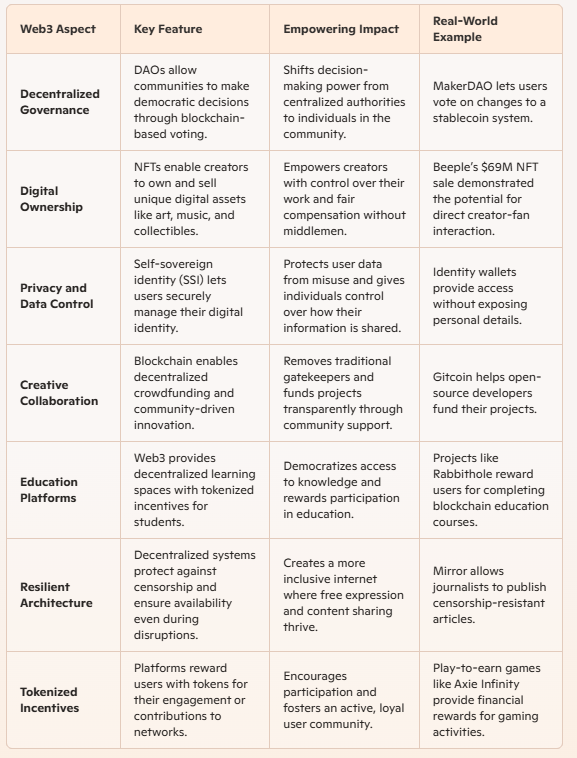The internet has grown tremendously over the years, evolving from basic web pages (Web1) to the dynamic platforms of Web2 we use today. Now, with Web3 emerging as the next stage, it’s changing the way we think about ownership, collaboration, and connectivity online. However, many people associate Web3 solely with cryptocurrencies and financial speculation, dismissing it as a playground for traders or a get-rich-quick scheme.
This view overlooks the vast creative, empowering, and transformative potential of Web3. While financial applications like cryptocurrencies are an important part of the ecosystem, Web3’s scope extends far beyond speculation. It’s about creating new systems of governance, fostering digital ownership, protecting privacy, and enabling innovation in ways that were not possible before.
In this blog, we’ll debunk the myth that Web3 is “only for financial gain” and highlight its true purpose: to empower individuals, communities, and creators with tools for a more equitable and creative future.
Understanding the Foundation of Web3
Before diving into the non-financial applications of Web3, let’s first understand what it is. Web3, powered by blockchain technology, represents a decentralized internet where users have greater control over their data, assets, and interactions. It is built on key principles such as:
- Decentralization: No single entity controls the system; it’s distributed across many participants (nodes).
- Transparency: Transactions and records are stored on a publicly accessible and immutable ledger.
- User Ownership: Individuals own their digital assets, identities, and data instead of centralized companies.
This shift in structure means Web3 isn’t just for investment—it’s about enabling users to collaborate, create, and interact in an open and fair digital space.
Decentralized Governance: Giving Power Back to the People
One of the most significant aspects of Web3 is decentralized governance, which empowers communities to make decisions collectively without relying on centralized authorities. Through Decentralized Autonomous Organizations (DAOs), Web3 enables groups to govern themselves transparently and democratically.
What Is a DAO? A DAO is an organization that operates on blockchain through smart contracts, allowing members to vote on decisions. Unlike traditional organizations where a CEO or board makes key decisions, a DAO distributes power among its members.
Example of a DAO:
- Friends with Benefits DAO: This community creates and governs digital projects collaboratively, giving its members a voice in decision-making.
- MakerDAO: Members govern a stablecoin project by proposing and voting on changes to the system.
Empowering Aspect: Decentralized governance shifts control from corporations to users, fostering collaboration, creativity, and inclusion. DAOs can manage communities, launch projects, or even fund humanitarian initiatives.
Digital Ownership: A New Era for Creators
In the Web2 world, creators rely on centralized platforms to share their work, from social media to streaming services. However, these platforms often take a significant share of the revenue, and creators don’t truly own their content. Web3 changes this by enabling digital ownership through blockchain-based technologies like NFTs (Non-Fungible Tokens).
What Are NFTs? An NFT is a digital token that represents ownership of a unique asset—art, music, videos, in-game items, or even virtual real estate. Because NFTs are stored on a blockchain, their ownership is verifiable and cannot be altered.
Real-World Examples:
- Art and Music: Artists like Beeple and musicians like Kings of Leon have sold their work directly to fans as NFTs, bypassing intermediaries.
- Gaming: Games like Axie Infinity let players own in-game assets, which they can trade or sell.
- Virtual Worlds: Platforms like Decentraland and The Sandbox enable users to buy, sell, and build on virtual land parcels.
Empowering Aspect: By giving creators direct control over their work and enabling them to connect with their audience without middlemen, Web3 empowers creativity and ensures fair compensation.
Privacy and Data Control
In Web2, users often sacrifice privacy to access free platforms, as their data is stored and monetized by corporations. Web3 offers a different approach by enabling users to control their data through self-sovereign identity (SSI) and encrypted transactions.
Self-Sovereign Identity (SSI) SSI allows users to manage their digital identity independently, storing personal information in decentralized wallets. Instead of repeatedly sharing sensitive data with platforms, users can verify their identity without exposing private details.
Real-World Example:
- A Web3 application might let you prove your age or residency without requiring you to reveal your full name or address.
Empowering Aspect: Web3’s privacy tools protect individuals from surveillance, data breaches, and misuse, fostering a safer and more secure online experience.
Creative Communities and Collaboration
Web3 is also transforming how people collaborate and build communities. By eliminating the need for intermediaries, Web3 enables people to create, share, and fund projects directly.
Crowdfunding on Blockchain Traditional crowdfunding platforms often take fees and impose rules on campaigns. Web3 offers alternatives through decentralized funding platforms like Gitcoin or Giveth. These tools connect creators with supporters transparently and efficiently.
Example: An artist can fund a digital art project through contributions from a decentralized community, rewarding backers with NFTs or tokens.
Empowering Aspect: Web3 enables creators and entrepreneurs to bring their ideas to life without restrictive gatekeepers, unlocking new possibilities for innovation.
Education and Innovation
Web3 isn’t just about existing industries—it’s driving innovation and enabling new fields of knowledge. From decentralized education platforms to scientific collaboration, Web3 offers tools for a more open and collaborative future.
Examples of Web3 in Education:
- Decentralized Learning Platforms: Teachers and students can connect directly, with courses and credentials stored securely on blockchain.
- Tokenized Incentives: Students can earn tokens for completing courses, which can be used for further education or funding.
Empowering Aspect: Web3 democratizes access to knowledge, ensuring that education is transparent, accessible, and rewarding.
Breaking Free from Centralized Systems
Web3’s decentralized architecture reduces reliance on centralized systems, making it more resilient to failures and censorship. This is particularly important in regions where freedom of expression or access to digital tools is restricted.
Real-World Impact:
- Journalism: Decentralized platforms like Mirror allow writers to publish their work securely, free from censorship.
- Freedom of Expression: Blockchain-based systems provide a platform for marginalized voices to be heard, even in restrictive environments.
Empowering Aspect: By bypassing central authorities, Web3 ensures inclusivity and freedom for individuals worldwide.
Beyond Speculation: A Vision for the Future
While financial gain is an important aspect of Web3, it’s just one piece of a much larger puzzle. The true potential of Web3 lies in its ability to empower individuals, foster creativity, and build resilient systems that prioritize user control and collaboration. Whether it’s through decentralized governance, digital ownership, or privacy protections, Web3 offers tools to create a fairer and more inclusive internet.
Summary Chart
And to help us navigate and learn, ask more questions and get emersed into Web 3, here is a chart of what we just reviewed:

Conclusion: Busting the Myth
The myth that Web3 is only for financial gain overlooks its transformative potential. Web3 isn’t just about speculation—it’s about innovation, empowerment, and collaboration. By embracing decentralized governance, digital ownership, privacy, and creative communities, Web3 is shaping a more equitable internet that benefits everyone, not just investors.
As Web3 continues to evolve, its applications will only grow, proving that it’s far from a passing fad or speculative bubble. It’s a powerful movement that’s revolutionizing industries and empowering individuals around the globe.
Want to stay informed about the exciting possibilities of Web3? Subscribe to Web3WondersUS today for insights, tips, and updates on how Web3 is reshaping the future of the internet. Let’s explore the decentralized revolution together!

